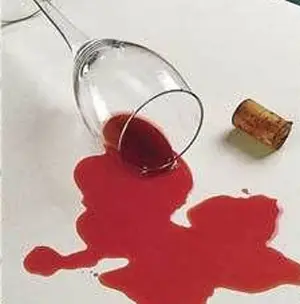
When removing stains from colored fabrics, it’s essential to consider the durability of the dye, the potential for spreading, and the harmful effects of stain-removing chemicals.
The most common stains on fabrics or clothing are grease, resin, lacquer, wine, fruit, and berry stains. In the past, a universal remedy for these stains was gasoline soap, which is made by dissolving half a bar of toilet soap in 100 grams of denatured alcohol. The soap should be grated beforehand. Place the soap-alcohol mixture in a pot of hot water and heat it while stirring continuously (do not place the mixture containing alcohol directly on the heat). Once the soap is completely dissolved, add a cup of aviation gasoline and a teaspoon of a detergent like OP-7 to the slightly cooled solution, stirring until it cools down. Store the finished mixture in a jar with a screw-on lid.
In addition to gasoline soap, you can use acetone, vinegar essence, or achieve guaranteed results with HG home care products, which are uniquely formulated to do the job for us.
It’s recommended to treat stains as soon as they occur, as older stains are significantly harder to remove than fresh ones, and some may never come out. When using any stain remover, always test it on an inconspicuous area first to ensure it won’t damage the fabric.
Removing Grease Stains. To remove grease stains, first dry potato starch over low heat, and once cooled, mix it with gasoline to form a paste. Rub this paste into the stain with a dry, clean cloth. Place a piece of plywood under the stained area to catch any drips.
For larger stains, to prevent spreading, cover the area with a thick layer of potato starch, which will absorb excess gasoline and keep it from spreading.
Stains containing protein and sugar, such as those from sauces, ice cream, etc., can be treated with gasoline soap. Rub a small amount of gasoline soap into the stain, then dampen it with warm water, let it sit for a bit, and rub again. Wipe away the soap with a damp cloth, working from the center outwards.
To remove oil paint, mix a small amount of gasoline soap with an equal amount of turpentine and rub this emulsion into the stain. Once the stain dissolves, wipe the area with a cloth dampened with warm water.
Dried oil paint is more challenging to remove; first, rub a turpentine-soap emulsion into the stain and let it sit for several hours. Then, scrape off the softened paint with gasoline soap and rinse with warm water. If the oil paint is heavily dried, it’s best to apply petroleum jelly and leave it overnight. Once the paint softens, the stain can be removed.
Removing Lacquer Stains. Lacquer stains can be removed with a mixture of acetone and denatured alcohol in equal parts.
Removing Canned Food Stains. Particularly for fish, these stains can be treated with acetone.
Removing Sweat Stains. To remove these stains, mix gasoline soap with an equal amount of ammonia. Rub this mixture into heavily soiled areas (collars, cuffs, hat bands, etc.) with a stiff cloth. Rinse the cleaned area with warm water, followed by warm table vinegar.
Removing Water Stains. Some fabrics may retain stains after rain. These can be removed by steaming with a hot iron through a damp cloth. You can also use a powder called “Novost.” Dissolve one teaspoon of the powder in a liter of warm water and wipe the stains with this solution. After removing the stains, refresh the fabric with rainwater or distilled water.
Removing Protein or Starch Stains (blood, milk, eggs, starch, beer, kvass, etc.) can be done with an OP-7 solution (one teaspoon per liter of warm water). For older stains, scrape them with a mixture of equal parts denatured alcohol, acetone, and ammonia. After removing the stain, wipe the cleaned area with a cloth dampened with weak vinegar.
Removing Ink Stains from Colored Fabrics. These stains should be treated with caution. Vinegar essence, acetone, citric acid, and other stain removers can alter the fabric’s color, so always test on an inconspicuous area, like a seam or a scrap of the same fabric, before proceeding. If hot vinegar does not affect the fabric’s color, you can start removing the stain. To prevent the ink from spreading, create a protective circle around the stain. Melt paraffin and petroleum jelly in equal parts, then dip a cotton ball wrapped around a matchstick into the hot mixture and draw a protective circle around the stain, ensuring the mixture penetrates the fabric. After the mixture cools, begin removing the stain by dabbing it with a cotton pad soaked in hot essence mixed with water. The stain will gradually fade and lighten. After removing the stain, immediately sprinkle the area with baking soda and rinse with water. During the process, monitor the fabric to ensure it doesn’t change color. If it does, switch to hot glycerin. When working with essence, wear rubber finger cots, which are available at pharmacies. After removing the stain and rinsing the cleaned area, press the protective paraffin circle with a hot iron through absorbent paper, changing the paper several times until all the paraffin is removed.
When removing ink stains, sprinkle potato starch under the stain to absorb excess liquid and prevent spreading. Follow the same procedure as described above.
In another method for removing ink stains, gather the stained fabric into a bundle and tightly tie it with white thread, leaving a few millimeters from the stain. Then, submerge this bundle in hot essence, hot glycerin, or warm denatured alcohol and squeeze it out. Repeat this process several times until the stain is removed. If the fabric is submerged in essence, sprinkle the cleaned area with baking soda and rinse with warm water. When using glycerin and denatured alcohol, rinse the cleaned area only with warm water.
